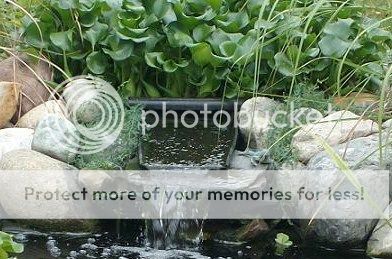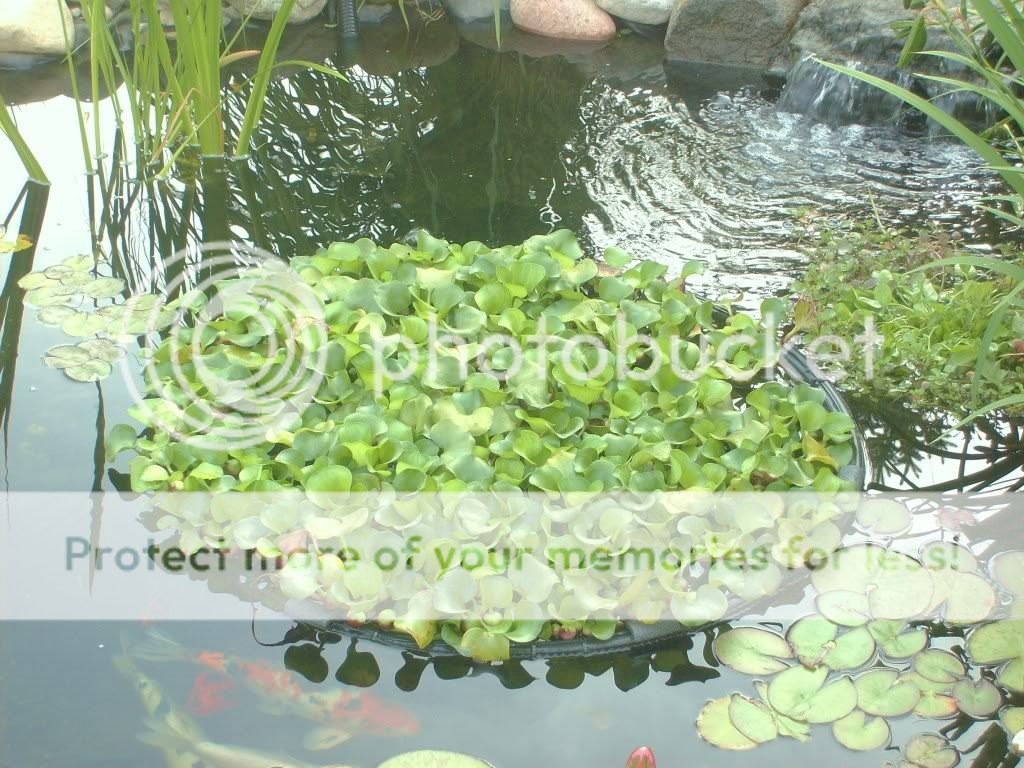Got this off a site that sells them locally in Iowa. Says they yellow due to lack of fertilizer.
Caring for Your New Water Hyacinth
Aqualand's inside info on growing Eichornia crassipes
Water Hyacinth Factoids
Origin
Amazon River basin -- mostly Brasil
Substrate
Immaterial
Fertilizers
Add if leaves start yellowing Uses Beautifies, purifies, provides shade and security Flowers Light purple blooms when temp hits 80[sup]o[/sup] Growth rate [sup]Fastest growing plant in the world[/sup]
Sun or Shade
Full sun best
Threats
Cold weather, salt, herbicides, children
Water
Removes pollutants from water
CH
Craig Hall's pic of his hyacinth ranch. Just kidding, Craig. Water hyacinths are pretty.
Origins: Originally from what most people call Brazil, water hyacinths came to the U.S. in 1880. They were brought to the Cotton Exposition in Louisiana, introduced into Florida, and from there quickly spread to all our southern states. Now considered a noxious weed in these states and “the worst aquatic plant,” they are illegal to export or import into these and several other states. They grow so fast that they block waterways and impede navigation in many states.
Movie Stars: If you saw the movie “Anaconda,” you saw their boat plow thru vast quantities of water hyacinths. It was a sad movie, because the anaconda died at the end.
Really attractive flowers.
Floating Plants: You don’t plant water hyacinths in special pots; you just toss them in the water. Their air-filled leaves keep them afloat. They float like a green-leaved cork. You don’t even need to remember “green side up.” Their heavy roots automatically right them no matter what you do.
LA
Older roots turn black. New roots come in white.
Root System: Long heavily branched roots looking like they’re covered with black whiskers very efficiently remove fish wastes from the water. Older roots turn black. Younger roots are white. Roots can grow as long as 18 inches. If they reach a mud bottom, they grow even faster.
LA
Baby plant growing off the bottom left side.
Starting out: We trim our hyacinths back as far as possible. If you get yours elsewhere, pull off ALL dead or broken leaves. They will not repair themselves. Also pull off the excess roots. Trimming them back (a lot) encourages new growth and makes them look better. Dead or broken leaves will not repair themselves.
LA
Even this young plant has three daughter cells growing from its base.
Reproduction: Water hyacinths can reproduce by seeds in warm climates -- not in Iowa. Seeds can survive 15 to 20 years during crummy weather. However, most hyacinths reproduce by stolons (like strawberry runners). In good conditions they double in population every 12 days. In Florida, they can yield 200 tons per acre. All these traits make them a great pond plant for Iowa -- but not Florida.
LA
Once they look like this, they will not recover. Our fall weather really slows them down.
Iowa Winters: We see some reports saying hyacinths die at temps below 20[sup]o[/sup]. In Iowa backyards they stop growing at 40 and die out at 32. The first frost wipes them totally. If we had no winters in IOwa, they would be a noxious weed here also.
Substrate: It matters not what you put on the bottom of your pond. Water hyacinths will prosper. If you have a dirt bottom, they will very likely have access to more nutrients.
LA
With no fish in here, you can use any fertilizer you want. See photo at bottom for results.
Fertilizers: You will need to fertilize your fast-growing hyacinths if their leaves turn yellow. Use any fertilizer you know will not hurt your fish. If you have no fish in your pond. use any type of fertilizer you want. Small frequent feedings work better than one massive feeding.
LA
At the beginning of the pond season, water hyacinths arrive in bags of 100.
Excess Plants: Once they get a good start, you wind up with more than you need. At the end of the pond season, disposal of dead hyacinths can present a problem. We find the best solution involves raking them out of your pond, drying them a couple days, then mulching them with your lawn mower. If you leave them in your pond over the winter, they make a royal mess. Get the dead ones out as soon as possible. In some countries, they compost their hyacinths and use them to grow mushrooms.
Algae Cure: Water hyacinths control algae growth in two main ways. They reduce the amount of sunlight entering the water. They also suck out the nutrients that algae need to grow successfully.
LA
About 2 inches across at first, these baby hyacinths will explode in size and number.
Other Uses: In addition to looking good, water hyacinths also provide the security some fishes need. Their roots also serve as prime spawning areas. The roots also provide a home for tiny insects and other critters that fishes enjoy snacking upon.
Water: Water hyacinths grow in nearly any kind of water without salt in it. Copper will kill them, so will most algae treatments. The only algae treatment that lets them live is AlgaeFix.
LA
Trimmed water hyacinths ready for sale in Aqualand's front window.
Size: Most water hyacinths grow 12 to18-inches tall. They will grow taller -- up to three feet tall. Crowded conditions plus fertilizer make them really stretch out.
LA
Hyacinths in plastic trays in LA's backyard. They bloom when temperatures hit the eighties.
Last Word: Water hyacinths will grow for anybody. Lack a green thumb? Try the water hyacinths.
LA.














